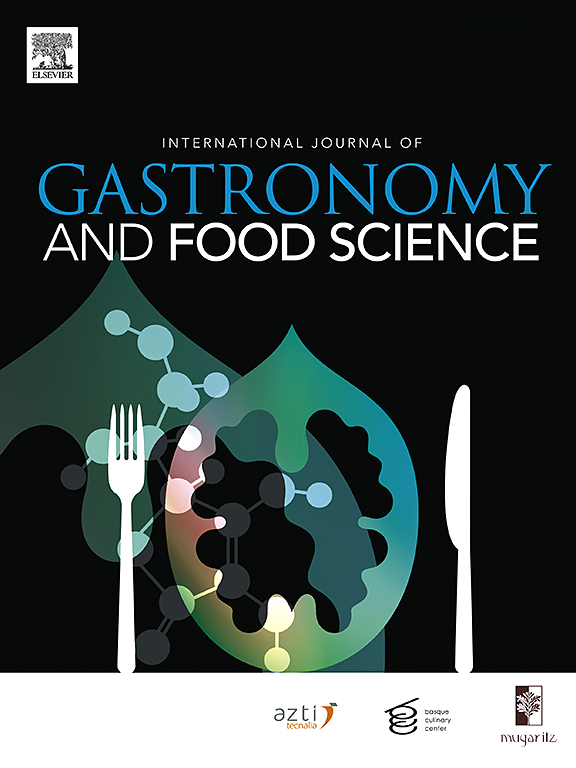From traditional knowledge to gastronomic heritage: Analysis of the cultural value and chemical properties of Jaji cheese
IF 3.2
2区 农林科学
Q2 FOOD SCIENCE & TECHNOLOGY
International Journal of Gastronomy and Food Science
Pub Date : 2025-04-21
DOI:10.1016/j.ijgfs.2025.101186
引用次数: 0
Abstract
This research examines the cultural significance, production processes and chemical properties of traditional Jaji cheese (known as herby acid curd or Çökelek cheese) produced in the Silopi district of Şırnak. The study used a mixed methodology in which qualitative and quantitative methods were integrated. The three-stage data collection process used ethnographic field observations, in-depth interviews with 12 traditional producers and comprehensive laboratory analyses. The findings have revealed three important dimensions of Jaji cheese production. Firstly, the fact that producers have acquired 10–50 years of experience and production knowledge primarily from female family elders highlights the critical role of women in preserving the traditional food heritage. Secondly, endemic Bıyıkotu (Diplotaenia sp.), locally known as ‘Siyabu’ in the region, is harvested in May and preserved through a brining technique before being incorporated into the cheese-making process. This herb, together with the other local herbs such as sirmo/sirik (Allium sp.), both give the cheese its characteristic features and also contribute to the maintenance of regional biodiversity. Thirdly, chemical analyses have revealed significant variations in terms of product fat content (15–24 %), dry matter (35.40–50.24 %), salt ratios (2.3–9.6 %) and pH values (4.08–5.58). While the majority of the samples are from the semi-fatty cheese class, the pH values were found to be appropriate for food safety. The research has revealed the diversity of gastronomic uses of cheese and its significant commercial potential as a regional product while offering strategic implications for the development of sustainable gastronomic tourism through women's cooperatives and cheese route initiatives. This comprehensive research also provides valuable insights into the preservation of cultural heritage in rural areas in Türkiye, regional development strategies and economic diversification through the commercialization of traditional dairy products.
从传统知识到美食遗产:Jaji奶酪的文化价值和化学特性分析
本研究考察了Şırnak Silopi地区生产的传统Jaji奶酪(被称为herby酸凝乳或Çökelek奶酪)的文化意义、生产过程和化学特性。该研究采用了定性和定量相结合的混合方法。数据收集过程分为三个阶段,包括人种学现场观察、对12个传统生产者的深入访谈和综合实验室分析。这些发现揭示了Jaji奶酪生产的三个重要方面。首先,生产者主要从女性家庭长辈那里获得了10-50年的经验和生产知识,这一事实凸显了妇女在保护传统食品遗产方面的关键作用。其次,当地特有的Bıyıkotu (Diplotaenia sp.)在当地被称为“Siyabu”,在5月收获,并通过盐水技术保存,然后加入奶酪制作过程。这种草本植物与其他当地草本植物,如sirmo/sirik (Allium sp.),都赋予了奶酪独特的特征,也有助于维持区域生物多样性。第三,化学分析显示,在产品脂肪含量(15 - 24%)、干物质(35.40 - 50.24%)、盐比(2.3 - 9.6%)和pH值(4.08-5.58)方面存在显著差异。虽然大多数样品来自半脂奶酪类,但pH值被认为是适合食品安全的。该研究揭示了奶酪烹饪用途的多样性及其作为区域产品的巨大商业潜力,同时通过妇女合作社和奶酪路线倡议为可持续美食旅游的发展提供战略意义。这项全面的研究还为基耶省农村地区文化遗产的保护、区域发展战略以及通过传统乳制品的商业化实现经济多样化提供了宝贵的见解。
本文章由计算机程序翻译,如有差异,请以英文原文为准。
求助全文
约1分钟内获得全文
求助全文
来源期刊

International Journal of Gastronomy and Food Science
Social Sciences-Cultural Studies
CiteScore
5.30
自引率
10.50%
发文量
170
审稿时长
45 days
期刊介绍:
International Journal of Gastronomy and Food Science is a peer-reviewed journal that explicitly focuses on the interface of food science and gastronomy. Articles focusing only on food science will not be considered. This journal equally encourages both scientists and chefs to publish original scientific papers, review articles and original culinary works. We seek articles with clear evidence of this interaction. From a scientific perspective, this publication aims to become the home for research from the whole community of food science and gastronomy.
IJGFS explores all aspects related to the growing field of the interaction of gastronomy and food science, in areas such as food chemistry, food technology and culinary techniques, food microbiology, genetics, sensory science, neuroscience, psychology, culinary concepts, culinary trends, and gastronomic experience (all the elements that contribute to the appreciation and enjoyment of the meal. Also relevant is research on science-based educational programs in gastronomy, anthropology, gastronomic history and food sociology. All these areas of knowledge are crucial to gastronomy, as they contribute to a better understanding of this broad term and its practical implications for science and society.
 求助内容:
求助内容: 应助结果提醒方式:
应助结果提醒方式:


